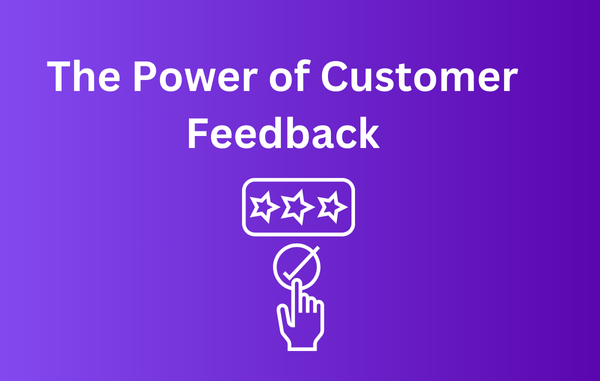
Understanding and utilizing feedback from customers is essential for any business seeking growth and improvement in today’s competitive market. The opinions of your customers about your goods, services, and brand experience as a whole can be gleaned from customer feedback in a big way. Businesses can enhance their offerings, increase customer satisfaction, and drive long-term success by effectively utilizing this feedback. How to improve your business by utilizing the power of customer feedback
1. Understanding the Value of Customer Feedback Customer feedback is a treasure trove of information that can help businesses make better choices. It aids in comprehension:
Customer Contentment: Customers’ levels of satisfaction with your products and services are shown in feedback, which also identifies areas for improvement.
Product Creation: Product development can be guided by customer feedback, ensuring that new products or features meet market demands.
Service Excellence: Enhancing customer support and service delivery can be made easier with a better understanding of customer experiences.
Market Trends: Feedback can help you stay ahead of the competition by identifying emerging trends and customer preferences.
2. Effectively Collecting Customer Feedback In order to Benefit from Customer Feedback, There are a few different ways to get feedback:
Surveys: Customers can be surveyed online to learn about their experiences. The creation and distribution of surveys is made simple by tools like SurveyMonkey and Google Forms.
Forms of feedback: Integrate feedback forms into your app or website to collect customer feedback in real time.
The Internet: Keep an eye out for direct messages, reviews, and comments from customers on social media platforms.
Reviews from clients: Customers should be encouraged to write reviews on sites like Trustpilot, Google, and Yelp.
Phone and email: Contact customers directly via email or phone to obtain in-depth feedback.
3. Analyzing Feedback From Customers After Collecting Feedback, Analyzing Feedback is the Next Step. This entails:
Classifying Feedback: Sort the feedback into categories like the quality of the product, the customer service, the usability of the website, etc.
Observing Trends: Look for common themes or issues that are brought up by a lot of customers.
Analyses of the Quantities: Measure levels of customer satisfaction and identify patterns using quantitative survey data.
Qualitative Research: Examine open-ended responses to learn more about customer opinions and ideas.
4. Implementing Changes Based on Feedback The best use of customer feedback is in making improvements. How to effectively implement changes is as follows:
Set Priorities: Concentrate on resolving the most pressing issues affecting the majority of your clients.
Plan your actions: Make clear plans for putting changes into action, including timelines and teams responsible.
Transmit Changes: Inform your customers of the modifications you’ve made in response to their feedback. This demonstrates that you value their opinions and want to make their experience better.
Monitor Impact: Keep an eye on feedback after changes are made to make sure they have the desired effect.
5. Using Customer Feedback to Encourage Innovation Customer feedback can spur innovation. Use it to spark new ideas and creativity in the following ways:
Enhanced Product Features: Utilize feedback to improve existing products or create new features that satisfy customer requirements.
Enhanced services: Based on customer feedback, implement novel technologies or procedures to innovate your approach to customer service.
Strategies for Marketing: Make adjustments to your marketing strategies and messages to better connect with the needs and preferences of your target audience.
Expansion of the company: Based on customer feedback and trends in demand, find opportunities for expanding your product line or entering new markets.
6. Building Stronger Relationships with Customers Actively seeking and responding to feedback from customers aids in strengthening relationships with customers. How to do it:
Show gratitude: Let customers know how much their feedback means to your business by saying thank you.
Engage in Conversation: Engage in meaningful conversations with customers about their experiences and suggestions.
Establish trust: By making visible changes based on feedback, you can show that you care about your customers’ satisfaction.
Encourage Loyalty: Your brand’s retention and word-of-mouth referrals will rise as a result of satisfied customers’ increased likelihood of becoming devoted advocates.
7. Utilizing Technology for Feedback Management Make use of technology to speed up the process of gathering, analyzing, and implementing feedback from customers:
Systems for Customer Relationship Management (CRM): Track and manage customer interactions and feedback by utilizing CRM systems.
Tools for Managing Feedback: Utilize Zendesk or Qualtrics to efficiently collect and analyze feedback.
Analytical Software: Utilize analytics platforms to gain a deeper understanding of customer preferences and behavior.
Customer feedback is a potent tool for driving innovation and continuous improvement in your business. You can increase customer satisfaction, strengthen relationships, and achieve long-term success by systematically collecting, analyzing, and acting on feedback. Allow your customers to direct you in the direction of excellence and incorporate customer feedback into your business strategy.
Leave a Reply